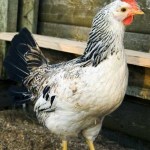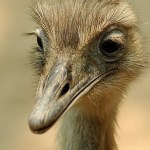Aves (birds)
Don't mess with me, man, I'm a Philippine Eagle, Pithecophaga jefferyi. You can call me Jeff.
This bird is almost extinct.
Azores Bullfinch, known locally as Priolo, is confined to eastern São Miguel in the Azores, Portugal. It has suffered through widespread loss of native forest and invasion by exotic vegetation, which has largely overrun the remaining patches of natural vegetation within the species's breeding range. These funds will enable the continuation of crucial habitat restoration work to increase the core range of this species. The exact number of bullfinches is unclear. In the 1990s the population was estimated at 200-300 individuals. However, surveys since 2002 have indicated a rise to around 340…
A "radiation" (sometimes called an "adaptive radiation") is when a single ancestral species gives rise to a number of novel species, often in a fairly short (geological) period of time. Following this radiation event, it seems often to be the case that subsequent speciation is less common. In fact, many living clades that have only a small number of extant species have such radiations in their history. It is quite possible that the radiation event occurred for reasons local in time and space, such as a recent extinction leaving various niches open, or the presence of a particular…
Well, it is migration season for many birds. The other day as we drove north to the cabin, we came across a flock of what I'm pretty sure were tundra swans resting on their long journey north. We are lucky to spend a lot of time in a major flyway for migratory birds, and we get to see lots of them.
Audubon and National Geographic have installed a web cam on Nebradka's Platte River in the Audubon Rowe Sanctuary, through which you can observe sandhill cranes (Grus canadensis). Look in the early morning and evening, at this URL.
I'm looking right now and can see that it is a bit windy, and…
Ten Short-tailed Albatross Phoebastria albatrus chicks have been moved by helicopter, from their current stronghold on Torishima Island to the site of a former colony 350 km to the South-east.
The potential for future volcanic events on Torishima is among the most serious threats to this Vulnerable species. Currently, 80-85% of the world population breeds on a highly erodible slope on the outwash plain from the caldera of an active volcano. Monsoons send torrents of ash-laden water down this slope across the colony site. A volcanic eruption could also send lava, ash or poisonous gases…
A bird that was known only from two records from the 1920s has been discovered in the Pacific after a gap of 79 years. Sightings of the Critically Endangered Beck's Petrel Pseudobulweria becki - published by the British Ornithologists' Club - have finally proven the species is still in existence, and delighted conservationists.
A voyage into the Bismarck Archipelago, north-east of Papua New Guinea, successfully managed to photograph more than 30 of these elusive seabirds. This included sightings of fledged juveniles - suggesting recent breeding. A freshly dead young bird salvaged at sea also…
Loons are the fish eating canaries of secluded northern lakes. Actually, over the last several decades, loons seem to have gotten more used to people then they used to be, but are still not really big on development.
My personal belief (based on anecdotal observation) is that loons can identify, to at least some degree, individuals. When I am alone with the loons, at the lake, strange things happen that don't happen to others or when others are around.
For instance, when I'm at the end of the dock fishing, the loons will commonly forage underneath the dock and all around me. The first…
Photograph of a chicken. Click to see larger version. From PLOS article cited in blog post.
Where and when were chickens domesticated?
From whence the humble chicken? Gallus gallus is a domesticated chicken-like bird (thus, the name "chicken") that originates in southeast Asia. Ever since Darwin we've known that the chicken originated in southeast Asia, although the exact details of which one or more of several possible jungle fowls is the primal form has been debated. The idea that more than one wild species contributed to the early chicken has been on the table for a long time,…
A flourishing wetland on Kenya's northern coast is under serious threat from plans to grow vast amounts of sugarcane, partly for biofuel production. Developers want to transform nearly 20,000 hectares of the spectacular Tana River Delta, into sugarcane plantations with other parts of the Delta earmarked for rice.
"This development would be a national disaster, wreaking havoc with the area's ecosystem and spelling the end for wildlife across much of the Delta", said Paul Matiku, Executive Director of NatureKenya. "Large areas would become ecological deserts. The Delta is a wildlife refuge…
Everyone knows about Darwin's Finches, of the Galapagos Islands. But of course, Darwin made observations of birds throughout his travels on The Beagle. Here, I present a number of passages from The Voyage that include some of these observations.
Struthio Rhea
I will now give an account of ... the Struthio Rhea, or South American ostrich. This bird is well known to abound over the plains of Northern Patagonia, and the united provinces of La Plata. It has not crossed the Cordillera; but I have seen it within the first range of mountains on the Uspallata plain.... The ordinary habits of the…
Darwin's finches are a classic and historically important example of a species radiation (sometimes called an "adaptive" radiation, but that implies a specific assertion about the cause of the radiation which may not be appropriate in all cases). During the five weeks that Darwin spent on the Galapagos in September, 1835, he made a number of observations of these birds, but they did not occupy his time or attention more than any other aspect of this remarkable archipelago of islands. It seems that Darwin did not recognize all of the finches as finches, thinking some were of an entirely…
One of the most compelling argument that the story of Noah's Ark is made up is the implausibility of having animals like tigers and lions together with animals like lambs and deer on the same boat for very long. The big carnivores would eventually eat the little cute furry things. The bunnies would be the first to go. But new evidence, shown on the Miracle Pet Show disproves this objection.
So, if it is god's will, or if people just darn try hard enough, anybody and anything can get along with anything and anybody. Put that on an inspirational poster and hang it, I say!
Or is there…
Cornell Lab or Ornithology has always had a lot of good stuff on the web. Now, they have a new site called Living Bird. Go check it out.
It's basically an online journal with a lot of cool articles, including some science, birding advice, etc. ... and outstanding bird pictures.
Hat tip: Biological Ramblings.
And, speaking of Birds in the News, have a look at this particularly interesting Birds in the News post over at Living the Scientific Life. Here.
Pasteurella multocida is a bacterium often called Avian cholera (though it is a different organims than the disease that affects humans). It is estimated that about 15,000 birds have died over the last few weeks in the Great Salt Lake, in Utah. A similar epidemic occurred in 1994, killing 10,000 birds.
There are writeups here at the New York Times and here at the USGS.
A translocated population of the Critically Endangered Laysan Duck has reached 200 in only three years.Anas laysanensis is commonly known as the Laysan Duck. It occurs in the Papahanaumokuakea Marine National Monument, and nowhere else, though it was once found across the Hawaiian Island chain. They were nearly wiped out by 1860, confined thereafter only to Laysan Island.
One of the problems for these ducks is that invasive rats eat their eggs.
In 2004 and 2005, 42 individuals made a 750-mile voyage across the Pacific and were released at Midway Atoll NWR, managed by the U.S. Fish and…
The 11th Annual Great Backyard Bird Count, run by Cornell's Ornithology Lab and the National Audubon Society, is set for February 15th to 18th. Anyone can participate, and enter their results on line.
The reports contribute valuable scientific information for conservation, spotlighting changes in bird population and distribution from year to year. Participation is free, and no registration is required.
Last year, birders submitted a record-breaking 80,000 checklists -- reporting 11 million birds and 613 species. Count results over the years show how such species as the Eurasian-collared…
Efforts to save the Middle East's rarest bird have been boosted by two chance sightings of the species 1,500 miles apart.
Now, if only they could get these birds together, they would have a flock. Sort of.
Here's a press release from BirdLife International:
Northern Bald Ibises were seen last month in the Jordan Valley for the first time in 13 years, and in Djibouti, east Africa, for the first time ever, raising hopes that numbers of this species are not as low as scientists fear.
The bird was thought extinct in the Middle East in the 1990s before a colony of just six birds was found in…
We are seeing odd and mixed reports from Alaska, where it is said that perhap more than fifty eagles "dove into" a truck full of fish guts in the vicinity of Kodiak National Wildlife Refuge. The fish guts were from Ocean Beauty Seafoods. Twenty eagles died during the incident, about 30 were cleaned up and saved by Fish and Wildlife workers, and two eagles died during the cleanup.
It is a bit frustrating that there are no real details about this incident. Was the truck moving? Exactly how did the eagles die? Did they get fish guts on them and then die of exposure? Did they all run into…
Texas is the winter home of the only self-sustaining wild population of Whooping Cranes Grus americana in the world and this winter record numbers have completed their migration and returned to the southern state.
Whooping Cranes have been on the endangered species list since 1970, when only 56 birds survived in the wild in the world. These birds nested in Canada and migrated south to spend the winter in Texas.
Since then, habitat conservation and protection of the birds has enabled the wild population to increase and in 2007 there were a total of 73 pairs which produced 80 chicks, of which…
Corey at 10,000 birds has an interesting post weighting the value of gray squirrels as a visitor to your bird feeder, vs. the nuisance they cause as a visitor to your bird feeder. Last summer, I found a way to combine both perspectives.
Up at the cabin, the habitat is mixed woodland, so we have a high diversity of squirrel species. I assume there are flying squirrels buzzing around at night; There are marmots, but not many. There has been one red squirrel often seen near the wood pile; and in June, there was a pair of gray squirrels, seen most often, not surprisingly, at the bird feeder…

